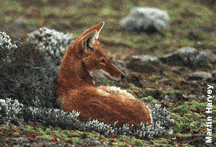Endangered Means There’s Still Time
Endangered Means There’s Still Time
by Neil Hutt
Editor’s Note: This article originally appeared in the Fall 2002 issue of International Wolf Magazine.
Time may be running out for one of the world’s rarest and most endangered canids. Ethiopian wolves (aka Ethiopian jackals), numbering fewer than 400, face in-creasing threats to their survival. The recent population decline of this highly specialized carnivore is due mainly to habitat loss from subsistence agriculture and livestock grazing. Ethiopian wolves are also threatened by direct persecution, hybridization with domestic dogs and exposure to infectious diseases such as rabies and distemper.
An article in the Spring 2001 issue of International Wolf (On the Edge of Extinction: Saving the Imperiled Ethiopian Wolves) alerted readers to the necessity for swift intervention from the international community. The Ethiopian Wolf Conservation Program (EWCP) considers such an initiative essential to diminishing the possibility that this unique predator will become the next mammal candidate for extinction.
The EWCP, established in 1995, is acting to save Africa’s only possible wolf species. (Authorities still disagree on whether this animal is a true wolf or a jackal.) Using the Ethiopian wolf as a flagship species, the organization is working to consolidate the management of protected areas and to monitor and manage the remaining wolf populations. Strategies include reducing the impact of domestic dogs in wolf range through vaccination and control programs. Additionally, the EWCP is carrying out community education campaigns to promote responsible dog ownership and to raise conservation awareness among the Ethiopian people. A captive-breeding program is planned to promote Ethiopian wolf genetic variability.
The work of the EWCP is receiving international attention through its official Web site. The site contains extensive information on the biology and status of the Ethiopian wolf, photographs, the annual report of the EWCP and a complete bibliography. Also on the Web site is a section detailing the ways in which the public can help the EWCP safeguard the future of the Ethiopian wolf and the Afro-alpine ecosystem where it lives.


